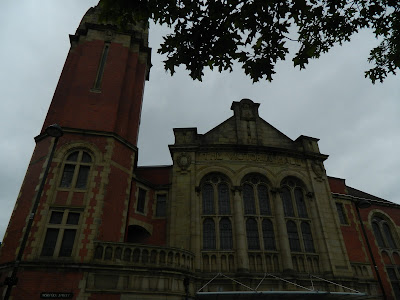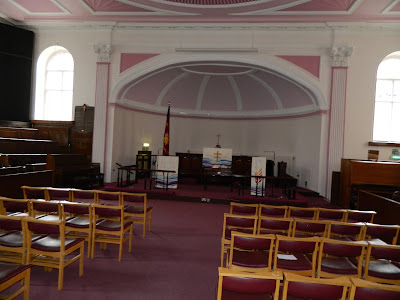Saturday 26th September
 |
| Hips & Haws out side Bath Abbey |
Today we join "Hips & Haws" for a dance out in Bath. As we approach the end of September the weather was kind to us although there was a nip in the air first thing by tea time it was tee-shirt weather. This was the first opportunity to have some real time off since my welcome service at the beginning of the month, but also to upload on to the blog information about Wesley influence on the city. I wonder what he would have made of the Morris & Clog dancers performing in the Abbey courtyard? - compared to some of the street performers of Bath, Morris Dancing is probably quite tame! It was also a chance to catch up with friends Peter and Truda Uglow from Chippenham.
Baths golden era began in the 18th century with two royal visits in 1734 & 1738, it quickly became a pilgrimage ( using the old Roman Road from London to Cornwall) for the upper classes both for those wishing to "take the waters" but also for the amusements (including dancing) the city provided by the city "Master of Ceremonies", Richard 'Beau' Nash who was proclaimed "King of Bath" by popular vote! Wesley records in his journal for Tuesday 5th June 1739:
"There was great expectation at Bath of what a noted man was to do with me there; I was much entreated not to preach, because no-one knew what might happen.... When there Champion appeared, and coming close to me, asked by what authority I did these things. I replied, "By the authority of Jesus Christ, conveyed to me by the Archbishop of Canterbury, when he laid hands on me... Sir did you ever hear me preach?, "No" How then can you judge of what you have never heard? "Sir, by common report" .. Common report is not enough, Sir, is not your name Nash? "My name is Naish." Sir, I dare not judge of you by common report!" - "Sir, leave him to me: let an old woman answer him. You, Mr Naish, take care of your body; we take care of our souls; for the food of our souls we come here," He replied not a word, but walked away."
When he returned to London he left a considerable number of enthusiastic Christians behind. By 1755 the earlier opposition to preaching seems to have fallen away, indeed the wealthy were interested in meeting Wesley, such that, in 1755, he could write ‘I dined with some serious persons in a large stately house standing on the brow of a delightful hill. In this paradise they live in ease, in honour and in elegant abundance. And this they call retiring from the world!’ Whilst there is no evidence, this possibly could well have been Ralph Allen’s mansion at Prior Park. In 1759 records show that the Bath Society was one of twelve within the Bristol Circuit as Circuits were large and preachers few, membership 35, 15 of these lived in Avon Street, which had a reputation as a place of ill repute. However the Bath Society decided to move out of its rented room in Corn St into a preaching house in Avon St, helped by its transfer into the "Wiltshire" Circuit. Wesley records. " The Chapel in the midst of sinners where I never heard an immodest word, but prayers and blessings in abundance." Unfortunately the move led to a further decline and by 1769 membership was eleven.
However The Countess of Huntingdon in her pursuit of Chapel building started to build a new Chapel
 in The Paragon which opened in 1765 - this didn't help the Avon St Chapel as it was in direct competition for Methodist Souls. However both John and Charles offered to preach in the new Chapel in The Paragon as a gesture of friendship. However these offers were seen as a Calvanistic take over and led to a bitter dispute. Today the Countess of Huntingdon Chapel is owned by the Bath Preservation Trust and open daily to visitors.
in The Paragon which opened in 1765 - this didn't help the Avon St Chapel as it was in direct competition for Methodist Souls. However both John and Charles offered to preach in the new Chapel in The Paragon as a gesture of friendship. However these offers were seen as a Calvanistic take over and led to a bitter dispute. Today the Countess of Huntingdon Chapel is owned by the Bath Preservation Trust and open daily to visitors.
One Sunday in 1765 an Army Officer turned up in Avon St Chapel, thinking he might be the preacher, he was invited to preach. Capt Webb gave an inspiring account of his conversion that John Wesley appointed him a preacher on the basis of the account. When Capt Webb was station in America he had earned the title " American Methodism number one Layman" He returned to Bath in 1784 after suffering detention during the war of independence. He also was instrumental is setting up the Methodist Class System and collections within them to help the poor. By 1770's the Bath Society had grown and John Wesley Supported the building of a new Chapel in New Kings St. John officiated at the opening in 1779. He saw this a model of future Chapel buildings: “Let every square house be built after the model of Bath or Scarborough”. This included: “doors and windows enough ... no tub pulpit but a square projection with a seat behind ... no pews and no backs to seats ... seats parted in the middle by a rail running all along to divide the men from the women .... plain and decent ... no more expensive than is absolutely necessary.”
In 1790 at the age of 87 John made his final visit to Bath, preaching at 6am that day and again on 4th Match at 3.45 and in the evening. At the desire of John Wesley the conference following his death, the Bath Circuit was officially formed,
 |
| New King St Chapel c1830 |

As Methodism began to split after Wesley's death, The United Methodist Free Church built a Chapel Beechen Cliff and the Primitives had premises at 4 Westgate buildings. However the now Wesleyans of New King St Chapel continued to grow, building a second Church in Walcot and in 1847 a new Gothic style Victoria Church opened in New Kings St replacing the former Chapel. Unfortunately during WWII Kings Street Church was completely destroyed. Today a plaque commemorates the spot the church once stood.
 |
| Walcot Methodist Church |
A short walk from the Countess of Huntington Chapel in The Paragon is Walcot Methodist Church, known as "Nexus" Which opened in May 1816. It was one of the first Methodist building to have an organ which was installed in 1818 – when organs were not officially approved for Methodist churches!
I had fond memories of visiting Walcot when My brother lived in "Chapel House" next door during the early 1980's whilst studying for his PhD - one of his jobs was to turn on the boiler early morning every Sunday for Church Services - not an easy job for any student!
 |
| Chapel House next to "Nexus" Church, Walcot |
Methodism in Bath is probably best known today for Kingwood School founded by John Wesley in 1748 and as the name suggest was situated in Kingwood (Kings Wood) outside Bristol. Originally established originally for the children of local colliers. It is the world's oldest Methodist educational institution. The school moved to its present location on the northern slopes of Bath in 1851 to provide an education for the sons of Methodist clergymen. During World War II the Kingswood buildings were requisitioned by the government and used by the Admiralty for military planning purposes. The school was evacuated to Uppingham School and continued to function from there. The Mulberry harbours used on D-day for the landing on the Normandy beaches were designed at the school and for many years is was thought that they were named after the Mulberry tree that still exists outside the front of the school, unfortunately this isn't true as Mulberry was simply the next code word on a list. Every September the Bristol District Synod is hosted by the school.
 |
| Kingwood School, Landsdown |
George White’s House was once a magnificent residence in the High Street Chippenham which was demolished in 1932 to make way for a new Woolworth store that continued to stand on the site until Woolworth went out of business a few years ago, Costa and Poundland stand on the site today. The frontage was taken down brick by brick and numbered and rebuilt on Sion Hill as part of the 6th form complex.
 |
| George White House, Kingwood School |













































